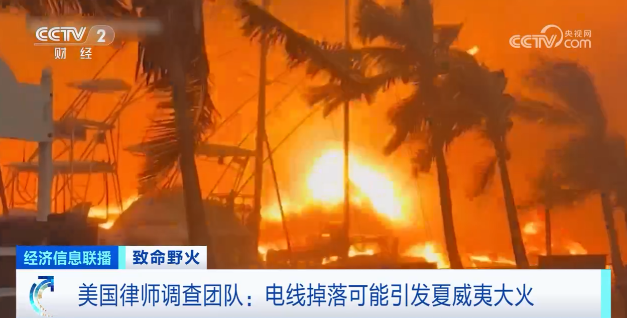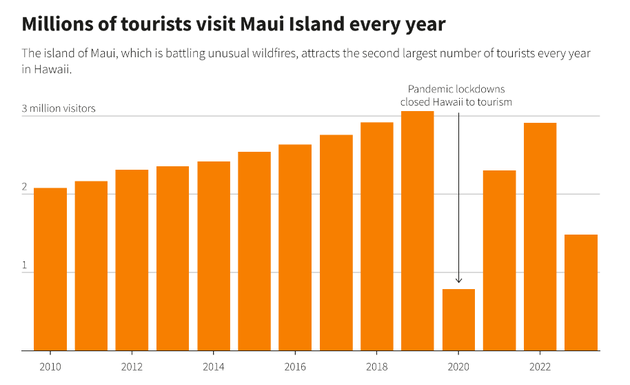On August 8, a wildfire swept through the historic seaside town of Lahaina on Maui Island in Hawaii, leaving most of the area in smoke and ashes. As of August 15, the death toll had risen to 106, with thousands still missing.
The fire started as a brush fire but quickly escalated into one of the most destructive fires in American history due to a combination of factors including sudden drought, flammable vegetation, and hurricane conditions.
The unprecedented wildfire has once again brought the issue of climate change into the spotlight.
Climate and community expert Andrew Rumbach, a senior fellow in the Metropolitan Housing and Communities Policy Center at the Urban Institute in Washington said in an interview with National Business Daily that "the science shows that climate warming is leading to more frequent, prolonged, and severe wildfires in places like the Western United States."
He added that many parts of the world are also at-risk to such wildfires, especially as human settlements expand into wildland areas and put them at greater risk. "Besides committing to a decarbonized economy to limit warming, countries like the U.S. should be investing in fire management, wildland firefighting capabilities, better land-use management practices to limit growth in the so-called 'WUI', and stronger efforts to mitigate risk that already exists through programs like Firewise. We have a lot of the knowledge we need to make these changes, but need the resources and political will to see them through."

Photo/Xinhua
As the fire spread further into towns, problems multiplied: community water systems collapsed, fire hydrants ran dry. More crucially, the powerful alarm system that Hawaii practices once a month never sounded - Lahaina's 911 system was paralyzed.
Despite some claims that text message alerts were received at the time, it is still unclear why warnings were not more widely disseminated. Many residents said that strong winds had disrupted communication systems hours before the fire arrived.
Chelsea Denton Fuka and her husband spent the day in extreme fear. They did not receive text message alerts, no alarm sounded, and no evacuation orders were given. They took some essentials and drove to escape, and the apocalyptic escape scene at the beginning was their real experience.
Many evacuees were trapped by road closures and fallen power lines, causing traffic jams. Some people were burned alive in their cars, while others were forced to jump into the Pacific Ocean for survival.
The speed of the fire shocked Steve and his wife who lived near Lahaina Luna Road at the foot of the mountain. They watched as flames along Lahaina Luna Road got closer and closer, first 100 yards away and then only 30 yards away in an instant, "like a freight train speeding down the mountain." According to Hawaii Governor Josh Green, wind speeds reached up to 81 miles per hour at the time, meaning that the fire advanced one mile per minute.
Thousands are still missing to this day and search and rescue operations are fraught with difficulties. Hawaii Governor Josh Green said it is difficult to estimate how long it will take for search and rescue teams to find and identify all bodies because "the fire left almost no survivors."
As of August 15, searchers had only completed searches of 32% of affected areas. Most victims have been found in open areas so far. Therefore local officials believe that as more burned areas are searched, the number of victims will increase significantly.
The source of this fire is still to be determined. But according to The New York Times, the brush fire that ultimately destroyed Lahaina was ignited under a broken power line.
Shortly after sunrise on August 8th, Sean True climbed onto a roof near Lahaina Road to repair damage when strong winds blew up on Lahaina's west-facing slope. Roof debris and thick panels from solar water heaters were blown off and landed on fences. That's when he heard a noise nearby.
"I heard a ‘bang,’" True recalled. “A wire was arcing on the ground and sparking. The ground at the base of the power pole turned black and then the wire ignited a nearby yard." He then called 911 and it took six minutes for police and firefighters to arrive separately. They arrived on scene with a water tanker truck and two front-end loaders to form a firebreak.
Bloomberg reports that preliminary investigations by a team of several American law firms show that damaged power facilities owned by Hawaiian Electric may have caused the fire. Witnesses said they saw power lines fall and then catch fire. The investigative team believes that under high temperatures and strong winds conditions, power companies should have cut off power in time but according to Hawaiian Electric's own statement they do not have a power cut-off plan for fire risk.


Victims have reportedly sued Hawaiian Electric for negligence in not taking measures to cut off power to reduce fire risk. This also caused the company's market value to evaporate by more than $1 billion in one day last week with its stock price plummeting by one-third. As of August 15 closing, its stock price had fallen to $14.79/share, down 60% from its closing price on August 7th.
"I can't comment on this specific lawsuit but I can say there are many examples of fires caused by fallen power lines in other parts of America," Jason Otkin, a research scientist at the Space Science and Engineering Center at the University of Wisconsin-Madison said to NBD that he is unable to speak about the merits of this particular lawsuit, but can say that there have been many examples where downed power lines have led to fires in other parts of the United States. "For example, Pacific Gas & Electric (PG&E) in California has been blamed for dozens of wildfires and has paid billions of dollars in settlements for damages caused by those fires. One of the main challenges is that it is simply too expensive to put all of the power lines underground in mountainous areas. This leaves the power lines exposed to branches falling on them when strong winds occur, which is especially problematic as the existing power lines age."
A sudden drought, invasive plants, and hurricanes formed a deadly combination. How did a brush fire that had already been controlled sweep through an entire town in just nine hours and escalate into one of the most destructive fires in American history?
First, dry vegetation and land laid the groundwork for the fire. Jason Otkin explained to NBD that one of the things that has caused fires to become more common in recent decades has been the closure of old pineapple and sugar cane plantations on the island. This has allowed an invasive species of grass (Guinea grass) to spread across the island. "Guinea grass grows very quickly and provides a large fuel source that is highly combustible. This means that even if the probability of extreme weather remains the same, that the likelihood of dangerous fires has increased due to changes in the vegetation."
The island was also hit by Hurricane Dora. "The normal easterly trade winds across Maui were stronger than normal because of a very strong area of high pressure to the north of the island. The passage of Hurricane Dora to the south also slightly strengthened the winds. The main driver of this fire was the strong downslope winds that had developed in the lee of the West Maui mountains in response to these strong easterly winds." Otkin analyzed.
"The combination of dry vegetation and extreme fire conditions led to a very explosive environment." he concluded.

Erica Fleishman, director of the Oregon Climate Change Research Institute also told NBD that high winds allowed the wildfire to spread quite rapidly. "Evacuation under such circumstances can be extremely challenging. Additionally, my understanding is that not all alert systems functioned effectively, so notification about the danger may have been limited in some cases."
In addition, the earth has just experienced its hottest July on record and climate change is increasing the likelihood of sudden droughts and other extreme weather events.
"Climate change is making large wildfires more likely because it is increasing temperatures and, in many parts of the world, aridity. Additionally, the human population continues to grow, and more people are living in areas with a high risk of wildfire." Erica Fleishman said to NBD.
Fleishman suggested that over the long term, reducing emissions of greenhouse gases is essential to minimizing the undesirable effects of climate change. "Over the shorter term, it is possible (although not always easy, fast, or cheap) to harden structures so they are less likely to burn; to develop more effective and equitable alert systems and evacuation procedures; and to help protect people from the adverse health effects of smoke."
For Hawaii, a tourist destination recovering from the pandemic, this most deadly wildfire in American history will also bring a heavy economic blow.
According to data released by AccuWeather, Maui Island's wildfire could cause losses of at least $8 billion to $10 billion for Hawaii.

Lahaina on Maui Island is an important tourist destination in Hawaii. After COVID-19 Maui Island led Hawaii's tourism industry rebound. Statistics from Hawaii’s Department of Business Economic Development and Tourism show that in the first half of this year Maui Island attracted over 1.48 million tourists accounting for 30% of Hawaii's total number of tourists; during the same period Maui Island generated $3.5 billion in tourist spending accounting for 32.3% of Hawaii’s total tourist spending.
Compared to other islands in Hawaii Maui Island relies more heavily on tourism and will suffer more direct economic impact. Data shows that Maui Island’s GDP was $10.3 billion in 2021 with tourism accounting for as much as 75%.
"The heavy reliance on tourism development makes this (Lahaina wildfire) have a greater economic impact," said AccuWeather senior meteorologist.


 川公网安备 51019002001991号
川公网安备 51019002001991号





